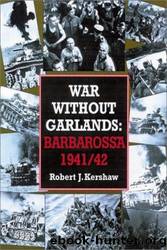War Without Garlands by Robert Kershaw

Author:Robert Kershaw
Language: eng
Format: mobi, epub
Tags: military_history
Publisher: Ian Allan Publishing
Published: 2010-11-15T00:00:00+00:00
They did not. As the lorry drove away for the fourth time the rope snapped taut around the victim’s neck, and he kicked his life away as the exhaust smoke dispersed. ‘There was no wailing,’ Dommerotsky remembered, ‘it was sinisterly quiet.’(46)
This was Kein Blumenkrieg – a war without garlands.[1]
Chapter 11
‘Kesselschlacht’ – victory without results
‘We will have to annihilate everything before this war is going to end.’
German soldier
Cannae at Kiev
On 20 August the Eastern Front presented a fascinating picture. Lead elements of Army Group Centre had occupied Yelnya, southeast of the Minsk–Smolensk–Moscow highway, holding a salient that appeared to point at the Russian capital. Some 600km due south on roughly a straight line, Army Group South had reached the River Dnieper at Kremenchug. This represented the forward wedge of a German front shaped like an isosceles triangle. Its western apex lagged 550km behind the leading eastern elements. Concentrated within the triangle was the entire Southwest Soviet Army Group situated south of the Pripet Swamps. Few commanders since Hannibal had ever enjoyed the prospect of achieving an operational double envelopment. Concept here verged on actuality.
On a hot August day in 216BC, an outnumbered Carthaginian force of 40,000 men commanded by Hannibal Barca surrounded eight Roman legions during the battle of Cannae. A feint toward the centre resulted in the double envelopment of the Roman Army of 86,000, twice the size of the Carthaginian force. Seventy thousand Roman legionaries perished, unable to escape. History appeared to be repeating itself more than 2,000 years later. Soviet Marshal Budenny’s Southwest Army Group was inside an enormous salient 240km wide that extended from Trubchevsk in the north to Kremenchug on the River Dnieper to the south. Kiev lay at the western extremity of the bulge. The conditions for a Cannae-like battle of encirclement were recognisable at this point, but only to those with a visionary operational view. Marshal Budenny had about a million and a half soldiers in this area, elements of eight armies, located mainly at Uman and Kiev itself.
Hitler’s controversial strategic directive to change the main axis of advance southwards was planned as a double encirclement. A preliminary inner ring was to be created by three manoeuvring German infantry armies. Second Army was to advance southeast from Gomel, Seventeenth would strike north from Kremenchug, while the Sixth Army fixed Russian attention on the centre at Kiev. The outer ring was to be formed by Generaloberst Guderian’s Panzergruppe 2 driving south from Trubchevsk with 500 Panzers to make contact with von Kleist’s 600 tanks of Panzergruppe 1 attacking north from Kremenchug, 200km east of Kiev. It was a carbon copy of Cannae. Carthaginian infantry lured the Roman legions into the heart of their concave formation in the centre, while cavalry, the precursor of the Panzers, smashed the wings and then enveloped the committed Roman infantry from the rear. The aim was not to defeat but annihilate the enemy.
As the German plan unfolded, the Russians appeared paralysed and incapable of decisive action. Nobody saw the awesome trap opening.
Download
This site does not store any files on its server. We only index and link to content provided by other sites. Please contact the content providers to delete copyright contents if any and email us, we'll remove relevant links or contents immediately.
| Automotive | Engineering |
| Transportation |
Whiskies Galore by Ian Buxton(41879)
Introduction to Aircraft Design (Cambridge Aerospace Series) by John P. Fielding(33064)
Small Unmanned Fixed-wing Aircraft Design by Andrew J. Keane Andras Sobester James P. Scanlan & András Sóbester & James P. Scanlan(32743)
Craft Beer for the Homebrewer by Michael Agnew(18140)
Turbulence by E. J. Noyes(7935)
The Complete Stick Figure Physics Tutorials by Allen Sarah(7307)
Kaplan MCAT General Chemistry Review by Kaplan(6866)
The Thirst by Nesbo Jo(6826)
Bad Blood by John Carreyrou(6552)
Modelling of Convective Heat and Mass Transfer in Rotating Flows by Igor V. Shevchuk(6391)
Learning SQL by Alan Beaulieu(6209)
Weapons of Math Destruction by Cathy O'Neil(6142)
Man-made Catastrophes and Risk Information Concealment by Dmitry Chernov & Didier Sornette(5921)
Digital Minimalism by Cal Newport;(5663)
Life 3.0: Being Human in the Age of Artificial Intelligence by Tegmark Max(5474)
iGen by Jean M. Twenge(5366)
Secrets of Antigravity Propulsion: Tesla, UFOs, and Classified Aerospace Technology by Ph.D. Paul A. Laviolette(5309)
Design of Trajectory Optimization Approach for Space Maneuver Vehicle Skip Entry Problems by Runqi Chai & Al Savvaris & Antonios Tsourdos & Senchun Chai(5011)
Pale Blue Dot by Carl Sagan(4910)
